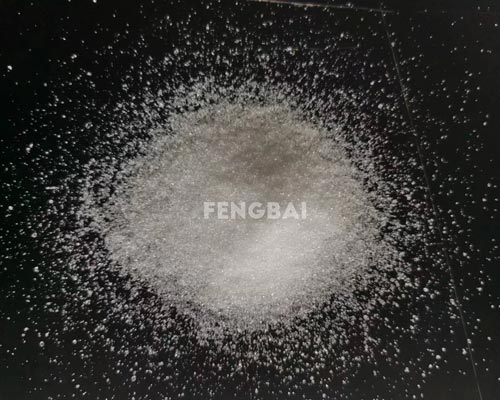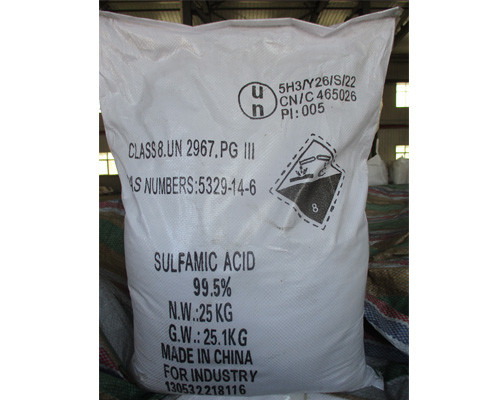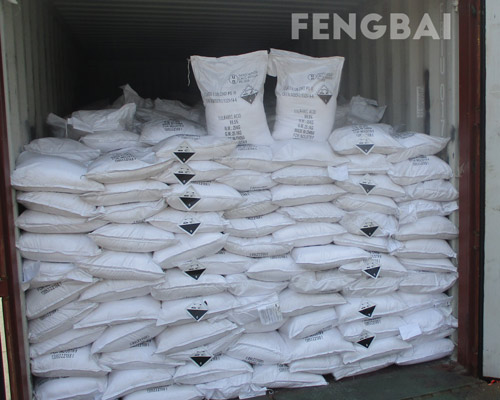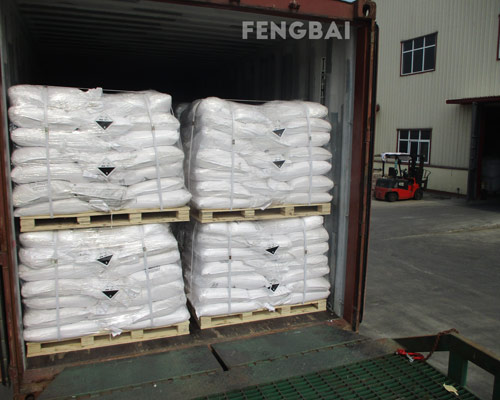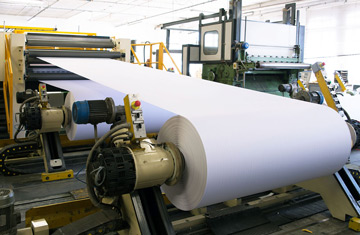- Name: Sulfamic Acid
- Form: White Crystalline Powder
- CAS No.: 5329-14-6
- MF: H2NSO3H
- HS Code: 2811199090
- Molecular Weight: 97.088
Sulfamic acid (also called amidosulfonic acid) is an inorganic solid acid formed by replacing the hydroxyl group of sulfuric acid with an amino group. It is generally a white, odorless crystalline powder with a relative density of 2.126 and a melting point of 205°C. And sulphamic acid is easily soluble in water and liquid ammonia. As long as it is kept dry and not in contact with water, solid sulfamic acid does not absorb moisture and is relatively stable.
| Item | Standard (HG/T2527-2011) |
| Purity % | ≥99 |
| Sulphate % | ≤0.2 |
| Fe, ppm | ≤50 |
| Water insoluble substance % | ≤0.05 |
| Loss on Drying | ≤0.1 |
| Heavy metal (Pb), ppm | ≤10 |
| Packing of sulfamic acid | Plastic woven sack with inner polythene film, N.W:25kg. G.W:25.1kg. 27MT/20’ FCL, if on pallets 25MT/20’ FCL. UN NO.: 2967 |
The aqueous solution of sulfamic acid has the same strong acidity as hydrochloric acid and sulfuric acid, so it is also called solid sulfuric acid. It has the characteristics of non-volatile, odorless and low toxicity to human body. As a common chemical raw material, sulfamic acid 99.5% can be widely used in the synthesis of herbicides, fire retardants, sweeteners, preservatives, metal cleaning agents, etc.
Main Applications of Sulfamic Acid
- Cleaning Agent. It can react with metal compounds to form soluble salts, has high solubility in water, does not precipitate, and has little corrosion to metals. Therefore, sulfamic acid can be used as a cleaning agent to efficiently remove rust and scale generated in the use of iron, steel, copper, stainless steel, lead, ceramics and other machinery and equipment, thereby greatly extending the service life of the equipment.
- Textile Industry. Used as a remover in the dye industry, a fixing agent for textile dyeing, forming a fireproof layer on textiles, and can also be used to make mesh agents and other additives in the textile industry.
- Paper Industry. Sulphamic acid can be used as a bleaching aid to reduce or eliminate the catalytic effect of heavy metal ions in the bleaching liquid, so as to ensure the quality of the bleaching liquid, and at the same time, sulfamic acid can reduce the oxidative degradation of metal ions on fibers and prevent the peeling reaction of fibers. , Improve the strength and whiteness of pulp.
- Oil Industry. Sulphamic Acid can be used to unblock the oil layer and improve the permeability of the oil layer. The sulfamic acid solution is injected into the carbonate rock oil-producing layer, because the sulfamic acid is easy to react with the oil layer rock, which can avoid the deposition of salt generated by the reaction. Although the treatment cost is slightly higher than with hydrochloric acid, the oil production is doubled.
- Agricultural. Aminosulfonic acid can be used as a pesticide intermediate in the production of herbicides, and as an anti-blight agent for trees or shrubs.
- Food Industry. It can be used as a raw material for producing sweeteners such as acesulfame potassium and cyclamate, and is a food and beverage additive.
- Sulfonating agent. Using sulfamic acid as a catalyst to produce AES has the characteristics of simple equipment, low corrosiveness, mild reaction, and easy control.
- Electroplating industrial agent. Using aminosulfonic acid in gold plating, copper plating or alloy plating can make the plating layer fine, ductile and highly viscous, and obtain a very bright silver plating surface. Sulfamic acid for sale is used to prepare aminosulfonic acid nickel and is used for low-stress sulphamic acid nickel electroplating, which improves the electroplating quality and shortens the cycle.
- Electrochemical polishing agent. In addition, sulphamic acid is also used for electrochemical polishing of titanium alloys and rhodium-rhenium alloys, which can increase the brightness of the alloy surface, thus being used for surface treatment in the aerospace and military fields.
- Stable physical properties. The Sulphamic acid 99% exhibits good physical stability at room temperature and pressure, and is not easy to decompose or deteriorate. It has a high melting point (about 205°C) and is not easy to absorb moisture in the solid state. These characteristics enable aminosulfonic acid to maintain its original chemical properties and physical state during storage and transportation, thereby ensuring the consistency of its application effect.
- Strong acidity. As an organic sulfonic acid, sulfamic acid has significant strong acidity. It can effectively release protons (H⁺) and react with a variety of alkaline substances to neutralize, showing a strong acidification ability. This strong acidity makes aminosulfonic acid widely used in a variety of chemical reactions and industrial production processes that require an acidic environment.
- Wide range of uses. Because aminosulfonic acid has a variety of excellent chemical properties, its application fields are very wide. From metal surface treatment to electroplating industry, from chemical synthesis to wastewater treatment, sulfamic acid plays an important role. Its diverse uses not only meet the needs of different industries, but also promote the progress and development of related technologies.
- Efficient descaling. Sulfamic acid performs well in cleaning and descaling metal surfaces. Its strong acidification ability and low corrosion to metals enable it to quickly and effectively remove impurities such as dirt, rust and oxides from metal surfaces, and restore the finish and performance of metal surfaces. This feature is particularly important in the fields of machinery manufacturing and automobile maintenance.
- Low metal corrosion. Although sulphamic acid is highly acidic, it is relatively less corrosive to most metals. This feature enables it to reduce damage to metal substrates when treating metal surfaces and protect the physical properties and structural integrity of metals. Therefore, aminosulfonic acid has become an ideal cleaning and rust removal agent in situations where metal substrates need to be protected.
- Active chemical properties. Sulfamic acid not only has the characteristics of strong acidity and low toxicity, but also has very active chemical properties. It can participate in many types of chemical reactions, including acid-base neutralization, esterification, sulfonation, etc. This activity makes aminosulfonic acid have a wide range of application potential in the fields of organic synthesis and catalytic reactions, providing strong support for scientific research and industrial production.
- Environmentally friendly. The waste liquid and waste gas generated by sulfamic acid during use have little impact on the environment. Due to its low toxicity and low volatility, it is easier for aminosulfonic acid to meet emission standards or be harmless after treatment. In addition, aminosulfonic acid can also be recycled through regeneration and recovery, further reducing its environmental cost. Therefore, sulfamic acid is considered to be an environmentally friendly chemical reagent and industrial raw material.
- Store in a dry, well-ventilated, and sealed warehouse with a temperature not exceeding 30°C and relative humidity below 70%. Keep away from oxidizers, other alkalis, moisture-sensitive flammables, and strictly separate from food raw materials.
- Packaging typically consists of an inner polyethylene (PE) liner and an outer polypropylene (PP) woven bag, with a net weight of 25 kg or 50 kg per bag. High-end products may use vacuum-sealed aluminum foil bags to protect against moisture.
- During transportation, avoid exposure to rain and direct sunlight. Handle gently during loading and unloading to prevent damage to packaging. In case of a spill, use dry sand or soil to absorb the material and collect it for proper disposal; do not flush with water.
Why Choose Fengbai
- As a leading supplier and exporter of sulfamic acid in China, Fengbai has more than 15+ years of experience in water treatment chemicals industry.
- Fengbai has its own factory, raw materials, large warehouse, the advanced technology and equipment.
- All of our products have passed ISO 9001, SGS certifications,etc.
- Our main markets are Europe, Southeast Asia, Middle East, Africa, South America, etc.
- We can provide high-quality product, excellent services and competitive prices for all the customers. And we are also looking forward to work with you!

